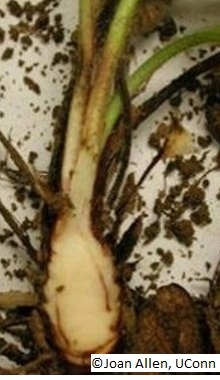Verticillium Wilt
Verticillium disease is a soil-borne fungus caused by six species of the Verticillium genus: Verticillium albo-atrum, V. dahliae, V. longisporum, V. nubilum, V. theobromae, and V. tricorpus. Over 350 host plants are susceptible to Verticillium wilt including members of the Solanaceous family (tomatoes, potatoes, peppers, and eggplant), the Brassica family (Brussel sprouts, cabbage, and cauliflower), Cucurbitae (cucumber and pumpkin), Fragaria (strawberry), black raspberry, fruit trees and other woody plants
In the Northeast, Verticillium albo-atrum nad V. dahlia can survive in the soil for many years. These species attack a wicde variety of plants including tomato, pepper, eggplant and potato. If plants are infected, remove and destro them. Rotate crops to avoid planting related crops e.g. if tomatoes were infected, do not replace the next several years with peppers or other nightshade family plants.
Life Cycle
The basic life cycle is similar across all species of Verticillium although V. albo-atrum forms mycelium, V. dahliae forms microsclerotia, V. nubilum forms chlamydospores, and V. tricorpus forms all three. These resting structures can survive in the soil anywhere from 4-15 years depending on conditions such as temperature, hydration, and non-host crops.
When the roots of a host crop come near the resting structures the root exudate (chemically diverse secretions) triggers the germination of the threadlike fungal structures and they grow toward the plant. Verticillium is a vascular disease and generally requires an opening in the root system to access the vascular structure of the plant. Verticillium produce conidia that are released into the plant xylem tissue and colonize the plant in as little as 24 hours. Verticillium is a cool-weather disease than grows best in the 70-85°F range.
Symptoms of the disease include wilting, mottling or chlorosis of the leaves, and discoloration of the vascular tissue in the roots and lower stems. Wilting may occur on only one side of a plant.
Heavily infected plants can succumb quickly and if not removed can release the survival structures into the nearby environment where they will wait for the next host to repeat the cycle. The disease can spread from root to root and through infected seed (up to 13 months). It is rarely spread aboveground to healthy plants. Insects that feed by cutting into a plant such as leaf hoppers and aphids can vector the disease from plant to plant.

Control
Once plants are infected there is no control. Plant disease resistant plants when available or avoid planting susceptible species in an area where the disease is known to have existed. Remove and bag or destroy any infected plant tissue, do not compost as most home garden compost piles do not get hot enough to kill the structures.
Despite good cultural practices, pests and diseases at times may appear. Chemical control should be used only after all other methods have failed.
For pesticide information or other questions please call toll free: 877-486-6271.
UConn Home and Garden Education Center, 2020
Issued in furtherance of Cooperative Extension work, Acts of May 8 and June 30, 1914, in cooperation with the U.S. Department of Agriculture, the Dean of the College, Cooperative Extension System, University of Connecticut, Storrs. The Connecticut Cooperative Extension System is an equal opportunity employer and program provider. To file a complaint of discrimination, write USDA, Director, Office of Civil Rights, Room 326-W, Whitten Building, Stop Code 9410, 1400 Independence Avenue, SW, Washington, DC 20250-9410 or call (202) 720-5964.